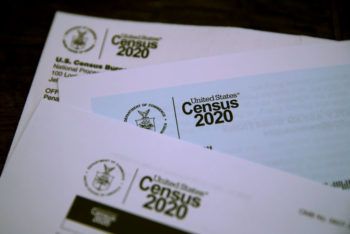Texas Will Lose Over $19 Billion In Federal Funding And 1 US House Seat Due To Census Undercount

There appears to have been a “serious undercount” of more than half a million Texans in the 2020 U.S. Census, said Texas A&M University Emeritus Professor of Sociology Dudley Poston, and it will cost the state a seat in the U.S. House of Representatives and result in a loss of over $19 billion in federal funding.
Poston, an expert in demography, and his colleague, Professor of Demography Rogelio Saenz at the University of Texas at San Antonio, analyzed data and estimates released this month by the U.S. Census Bureau from the Post-Enumeration Survey (PES) indicating the degree of undercount and overcount in the census.
The PES was conducted after census operations were concluded in order to determine its overall success in counting the population of the country. The PES is a survey of the populations of 10,000 sampled blocks in the country; every person living in those blocks is matched back to the 2020 Census enumeration. The data from the PES enable the Census Bureau to determine who was missed and who was counted more than once.

The research of Poston and Saenz noted that according to the PES estimates, 36 states, along with the District of Columbia, did not have a statistically significant undercount or overcount in the census. That is, the difference between their PES counts and their 2020 Census counts were not significantly different from zero.
But eight states had statistically significant overcounts, and six states, including Texas, had statistically significant undercounts. The Texas population was undercounted by an estimated 1.92 percent, meaning that 548,000 Texans were not counted, a number a little larger than the population of the city of Tucson, Arizona. “More people were missed in Texas than in any other state in the country,” Poston said. “Almost one in every 50 Texans was missed.”
Consequences For Texas
There are two big consequences, Poston said, one political and one economic.
“The political consequence is that when the results of the 2020 census were announced, Texas did not receive the three new seats in the U.S. House of Representatives that it was supposed to receive,” he said. “Texas was projected to gain three U.S. congressional seats based on the census results.”
The research of Poston, Saenz and many other demographers starting in 2016, showed that if current population growth trends continued for Texas into 2020, it would gain three new seats in the House, bringing its number of seats to 39. But Texas ended up receiving only two new seats.
Poston noted that Minnesota received the 435th and last seat in the 2020 apportionment of the House. “Had 267,000 fewer Texans been missed in the 2020 census count, Texas, and not Minnesota, would have received that last seat and would now have 39 seats, not 38 seats,” Poston said.
The economic consequence of the undercount will be an enormous loss of federal funds to the state of Texas. “Every year the U.S. allocates to the states $1.5 trillion — or $15 trillion over the decade — in federal funds for a host of federal programs which are distributed to the states on the basis of their population counts in the decennial census,” Poston said. “Based on its 2010 census count, over the last decade Texas has received over $100 billion dollars every year in federal funds.”
Poston and Saenz have estimated that owing to its undercount, Texas will end up losing over $19 billion in federal funds between now and 2031.
“For every person not counted in Texas, the state will lose every year around $3,500 in federal funds,” Poston said. “Multiply the $3,500 by 548,000, and you end up with $1.918 billion per year that Texas will not receive in federal funds. Multiply that by 10 years and you get $19.18 billion that Texas will not receive in federal funds between now and 2031.”
Why Did This Happen?
Poston said one of the reasons for the undercount was that getting a complete count of the Texas population was never a priority for Gov. Greg Abbott and his administration.
Poston and Saenz noted in their research that the state of Texas will feel the painful pinch as it pays the cost with fewer funds for education, health care, roads and highways, Medicaid and Medicare, housing support, elderly services, mental health, and more. These forfeited funds will not go back to the U.S. Treasury but will go to states with more accurate counts, like California.
“The governor of California, Gavin Newsom, devoted over $187 million in a ‘Be Counted California’ campaign, a statewide program designed to make sure all the residents of California were counted,” Poston said. “Kay Ivey, the governor of the small state of Alabama, with a population of just over 5 million people, smaller than the population of the metropolitan area of Houston, devoted several million dollars to an ‘Alabama Counts, 2020 Census’ campaign.”
Poston and Saenz noted that the new PES data show there were no population undercounts in either California or Alabama. “And these are only two examples. For the most part, states that developed complete count campaigns early did not have significant numbers of residents undercounted,” Poston said, noting that a complete-count campaign was never fully developed in Texas.
“Gov. Abbott and his administration for the most part opposed state-level funding to get a complete count of the Texas population,” Poston said. He and Saenz hold that Abbott and his colleagues likely believed that Latinos and other people of color, who tend to be associated with voting Democratic, would most likely be the people missed in the census. “So why develop campaigns to get more Democrats counted in the 2020 Census?” he said.
By late August of 2020, more than four months after the census began, Census Bureau reports indicated that the self-response rate for Texas households, even after follow-ups by census workers, was under 80 percent, a rate lower than those of several other states, and several percentage points less than the U.S. rate.
Poston said that was when the Texas Secretary of State noted the state had up to $15 million available to spend to encourage Texans to get counted. “But this last-minute effort had little effect,” he said. “The major enumerations had been done and were over. It was way too late to try to start a complete-count campaign.” Many of the complete-count campaigns in other states started one or two years earlier. California’s campaign started in April 2018 and Alabama’s in August 2018.
Moreover, Poston and Saenz noted that the census undercount outcome would have been far worse for Texas were it not for some Texas cities, including San Antonio, investing their own city funds in campaigns to obtain an accurate count of their populations.
Poston said another major reason for the undercount is the Trump administration’s moves to discourage Latinos from being counted. “Starting in 2018, Donald Trump and his administration attempted to add a citizenship question to the census, and they also tried to exclude undocumented people from the census count,” he said. “Trump also tried to halt early the actual process of the census enumeration.”
He said another reason for the undercount, especially in college towns such as College Station, is the possible undercount of college students. Owing to the rapid spread of the COVID-19 virus in early 2020, colleges around the country closed their campus classrooms in early March of 2020 and many students did not return to campus for the rest of the semester. The “official” Census Day was April 1 and college students are supposed to be counted in the census at their “usual residence” on Census Day.
Since most college students attend college away from their family homes, this means that most college students are not counted at their parents’ homes. Poston said, “We don’t yet know for sure how many college students were not counted in their college residences.” But he believes the number is not insignificant.
Poston said the possible failure of some college students to be counted, as well as the “exclusionary attempts” by Trump to keep some people from being counted, appeared not to have had an impact in most other states. He said this is mainly because the governors of many of the states not experiencing undercounts had early on developed state-level outreach and awareness programs.
“Texas has been shortchanged and will pay for it over the next 10 years,” Poston said. “Children, adults and older Texans, Republicans and Democrats, and urban and rural residents, will all get hurt by the shortage of funds to support what is rightfully theirs.”
Media contacts:
- Dudley Poston, d-poston@tamu.edu
- Lesley Henton, lshenton@tamu.edu





